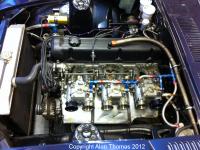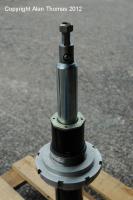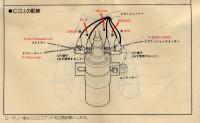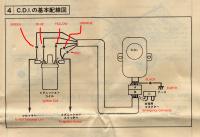Everything posted by HS30-H
-
Key differences between the American and European 260z
There are misconceptions about everything, though. Try telling people that "240Z" means more than one thing and they look at you funny. Same with "260Z". There's '260Zs' and there's '260Zs'.... There certainly were basic power differences for what appeared to be similar engines, depending on the period and the market. It may not be as much as the OP hoped - or as little as you think - but for sure there were differences in camshafts, compression ratios, ignition timing / timing curves and carburation, and that's before we start talking about any anti-pollution gear being hung on them. Like-for-like, year-for-year, I think you'll find that the 'Euro' market models will always have had more power than north American market models. Maybe not much, but worth noting.
-
Let's show vintage racing pictures. I'll start.
That's the old Fourways Engineering 'Bluezmobile' Modsports racer, here in the UK. Now in new ownership, but Fourways are still involved in prepping / running it. Many of the panels are alloy, and it has some interesting mods. Fast car. How come you seem to find so many photos that have been separated from their original source?
-
A buddy of mine posted this tasty little number on another forum...
It's a UK market car, as can be seen from the Road Fund License 'Tax Disc' attached to the windscreen. The license plate is a 'personal' plate, transferred from an earlier ( pre-February 1963 ) registered vehicle, and has no age-identifying suffix or prefix letter. Such numbers can be purchased from the UK licensing authorities, and transferred from car to car by the owner. This car would have been issued with a three letter, three number, one suffix letter registration plate when it was first registered in the UK in 1971,72, 73 or maybe even as late as 1974. The siffix letter would have been K, L, M or N.
-
Requesting documents on 1970's Nissan Motorsport coilovers
Very interesting, thanks. However, it kind of confirms what I have mentioned previously: If you were to view a video like that on it's own, you could be forgiven for believing that Nissan had put ALL of their race operations in the hands of NPTI and were doing precisely nothing in house, or even elsewhere. But in fact, nothing could have been further from the truth. The NPTI setup was one part of a global racing setup that Nissan had running at that point. Quite bittersweet to see the P35 mentioned at the end ( much promised, little delivered ) but it's a perfect illustration of what I'm talking about...
-
Requesting documents on 1970's Nissan Motorsport coilovers
Thanks John, but would they not have been called 'Datsun Competition ( USA )' at that point? Shirley 'Nissan Motorsports USA' was a later iteration that post-dated these parts, unless they are not as old as I'm imagining...? Whenever I see the name 'Nissan Motorsports' I think of Japan, and the works competition departments at Oppama, Murayama and Omori which would eventually become 'NISMO' ( their Telex address ) in 1982.
-
Requesting documents on 1970's Nissan Motorsport coilovers
For reference, here's a photo of an AMPCO E4621 Nissan 'Sports Option' gas-filled front strut. Note the screw near the top where the unit was filled with gas, the full-size spring mount and the short portion of thread for height adjustment / corner weighting:
-
Requesting documents on 1970's Nissan Motorsport coilovers
Darren, I don't think that's a Nissan Motorsports setup, I think it's a period local fabrication. Here's why: The 'coilover' type factory 'Sports Option' struts almost invariably used full-size springs that sat on wide alloy bases, with slots cut in them for tightening. Yours have smaller diameter ( 2.25" / 2.5"? ) springs, sitting on small platforms that have holes drilled for fastening. The threaded portions on your struts are about twice as long as the factory type too. They also appear to be welded all around the threaded portion, whereas the factory type only had short welded sections on them. The camber-adjustable top mounts on your setup are also different than the type Nissan used. The high-angularity uniball sandwiched into a two-half alloy housing is similar to the system the factory used, but they used an offset centre for their - limited - camber adjustment, and the camber was adjusted by turning the complete top mount whilst yours appear to be linear adjustable. However, the damper inserts themselves look just like the heavy duty Nissan Sports Option inserts - although they appear to be the oil-filled type rather than the gas-filled ones. Do you see any part numbers on them? If you can, I might be able to give you the bump & rebound data on them. The whole thing looks like a period-correct setup of good quality. I note the long wheel studs, drilled rear brake backplates and ( what appear to be ) modified steering knuckles too, but stock front discs. A competent race shop build from the early Seventies, perhaps? Something from a C-Production SCCA racer maybe? Hope that helps. Alan T.
-
Worn out rubber "rattle" insulators in Wiper control rods
I think you're mis-diagnosing the problem, and mis-identifying these "rubbers". What you are calling "rubber O-rings" are in fact felt washers which were designed to hold lubricating grease / oil for the eyeball joints in the linkage. If you replace them with rubber o-rings they will not lubricate the joints and will actually slow down your linkage through the drag they will create. I recommend you dismantle the whole linkage and pay extra attention to cleaning out the alloy castings that the wiper spindles pass through ( they have grease traps inside them, very likely fuull of solidified gunge now ) as this is where most of the stiction occurs, as well as washing out the eyeball joints with thinner or fuel, and re-greasing them. If you can't find replacement felt washers, you can cut some yourself from a suitable material. Soak or pack them in grease before fitting. Should work a lot better afterwards.
-
Datsun-240z Vs Fairlady-z432
Look out Fred, Carl wants to tell you that your Fairlady Z-L is "irrelevant" in person......
-
Sumitomo mk63 caliper question.
The Sumitomo MK63 four-pot brake caliper was first used on certain models of 150-series Nissan President limousines, from around 1965/66. Contrary to what other people might tell you, there are some variations in MK63 caliper models ( apart from vented / non-vented type ) and the details on them changed a great deal in early years of production. Seeing as the MK63 calipers were JAF and FIA homologated for several different Nissan models other than the S30-series Z, the answer to the question about differences between FIA MK63 and "just MK63" is that it depends on the application. The type normally used with the S30-series Z, in vented disc form, is the MK63-20S model. One of the differences between really early OEM application MK63 models and the 20S is the position and angle of the bleed screws, for example. Is this an enquiry with relation to FIA-sanctioned race use, or is it with regard to legalisation for road use in your country / region?
-
Clamp on steering rack?
Look at that. I hit the jackpot with a reply from 'Pontius' Pilati.... Woop de doo. Perhaps you'd like to explain how the words 'Factory' and 'Dealer' are pronouns in "Americanese"...? I can only speak for the English[/i ]language. And when you've finished with the side issue, maybe you'd be kind enough to explain the difference between "the Factory" and "the Dealer" for Carl, which is perhaps more to the point.... Unless that's different in "Americanese" too..?
-
Clamp on steering rack?
I was keeping you on your toes, and I'm going to get even more "pissy" now.... Sorry, but I think I was correct to pick you up on the difference. I don't know about anybody else, but when I hear or read about "the Factory" in relation to these cars, I think about Japan. You wrote: ...So you were - at the same time - making a distinction between "the Factory" and "The Datsun Dealer", which reinforced the implication that your shocks had been sent back to the factory three times, and the situation was finally resolved by fitting Koni inserts locally. In fact, the whole thing was happening locally wasn't it? I reckon any warranty claim would have been made to NMC USA ( via your dealer? ) and not Nissan Japan or 'the Factory'. I think it's worth making these things clear, and being careful to distinguish between the the places and people who built these cars, and the chain of supply and sales that came after they were exported. You might very well have had it in your head all these years that NMC USA was 'the Factory' or the equivalent of it, but I don't think the people at Nissan Japan or indeed Nissan Shatai would agree. Of course, the company which actually built your 'shocks' was yet another entity altogether... And, by the way, the words 'Factory' and 'Dealer' are not pronouns. They are proper nouns. Alan T.
-
Clamp on steering rack?
So Carl, did your 'shocks' actually get sent back to Japan ( to 'The Factory' ) or not? Genuinely interested to hear the answer ( and what your car was doing in the meantime..... ).
-
OEM JDM S30 PARTS Variation photos.
'Fairlady 240Z' ( and Fairlady 240Z-L and Fairlady 240ZG ) debuted in late 1971, so - to be complete - you'd need to cover the 1969 to late 1971 and on Fairlady Z, Fairlady Z-L, Fairlady Z432 and Fairlady Z432-R too. They are correct for a 'Fairlady', but they are most likely late 1973-on pieces ( therefore not Fairlady 240Z ) and from a 'Deluxe' spec car, as the 'Pass' button, sub loom and relay were an extra cost option on the base-model no-frills S30-S 'Fairlady Z' and the 'Pass' lettering was not seen until the L24-engined models had been dropped. The 'Pass' lettering was definitely on the S31 models right up until the debut of the S130-series in Japan.
-
Clamp on steering rack?
Carl, You used the 'F' word.... What happened to your car when the 'shocks' were sent back to the Factory those three times ( was it sitting on chassis stands? ) and how long did it take for the USA-Japan-USA turnaround?
-
What about the Z432-R ?
I have absolutely no problem with replicas, lookalikes, 'tribute' cars - whatever we want to call them ( I'm building a 432-R replica / lookalike myself.... ) - as long as they are correctly represented. The problems come about when people start thinking they are the real thing, and using them as datum points to judge others - sometimes, ironically enough, including the real thing - and getting it all wrong. Having said that, I don't know if there's some element of Lost in Translation involved in the story of the car in Thailand. The owner might not be calling it The Real Thing at all for all I know. It might be that the 7Tune guy got the wrong end of the stick. I'd give him the benefit of the doubt on that. The bigger problem is that getting it all wrong is a trait seen all too often on the like of 7Tune, Speedhunters and the others. These blogs have incredible power and are very influential. The stuff they publish spreads around the 'net like wildfire, and when it's wrong - as it so often is on obscure topics like the 432-R - it sticks. Even when you point out the mistakes, and if they allow them to stay in the comments section, people don't pay any attention or simply re-blog bowdlerised versions of the original. This is how the world will end, I reckon. Sisyphus had it easy, I tell you..... No, just the plain vanilla R192 ( R190 ) flat alloy cover, same as the 432. Easier to replicate... !
-
What about the Z432-R ?
Did you read the comments on the 7tune article? I don't belive that car is a genuine factory built PS30-SB Fairlady Z432-R. In any case, it hasn't been 'restored', it has been customised.......
-
Curiosity - Mars Science Lab. - landing tonight
Carl, You could have had a great career in the field of statistics...
- What makes a Z a Z? What modifacations go too far to be called a Z?
-
What makes a Z a Z? What modifacations go too far to be called a Z?
Well, as I'm most certainly not in NorthCoast, Ohio, I could say that I don't care what you call your cars there either. But that would be stupid, wouldn't it? So I won't..... What matters is what Nissan themselves called the cars, and that is something that you should certainly take notice of. Oh, it was a joke.....!?! CLANG! :stupid:
-
What makes a Z a Z? What modifacations go too far to be called a Z?
I'm sure you did ( and he was - of course - quite right ) but if he had even one tenth of the influence that people attribute to him, then he would have made sure that it happened. Instead, the market that he was responsible for got saddled with a four-speed trans and a 3.364:1 diff ratio...... More muddle-headed nonsense. You're forgetting ( of just ignorant of ) the fact that Japanese market models never got the 'X' tagged on to their model names. So, by your definition, a 1979 'Fairlady 280Z' is a Z, but a 1979 'Datsun 280ZX' is not...... :stupid: Ye Gods.......
- What makes a Z a Z? What modifacations go too far to be called a Z?
-
What makes a Z a Z? What modifacations go too far to be called a Z?
In what way would him being "behind and in front of the S30 marketing" ( even if that were completely true... ) make him the car's "creator"? Same goes for the 510 too. I notice he has never seemed to get himself too closely connected with the large numbers of other little sedans and pickup trucks sold during the same period. Maybe their paint wasn't shiny enough for him to see his reflection in it?
-
need help with ultra 9100 CDI
Three scans from the ( universal ) fitting instruction booklet that came with the 9200: P1 lists the parts included in the kit, P3 shows a basic wiring schematic and P7 shows the specific wiring at the ignition coil which should apply to your car. You can ignore the mentions of a 'Full Transistor' unit, as these apply to cars that were fitted with the Mitsubishi transistor ignition system from the factory ( ie S20 engined in this case ).
- What makes a Z a Z? What modifacations go too far to be called a Z?









